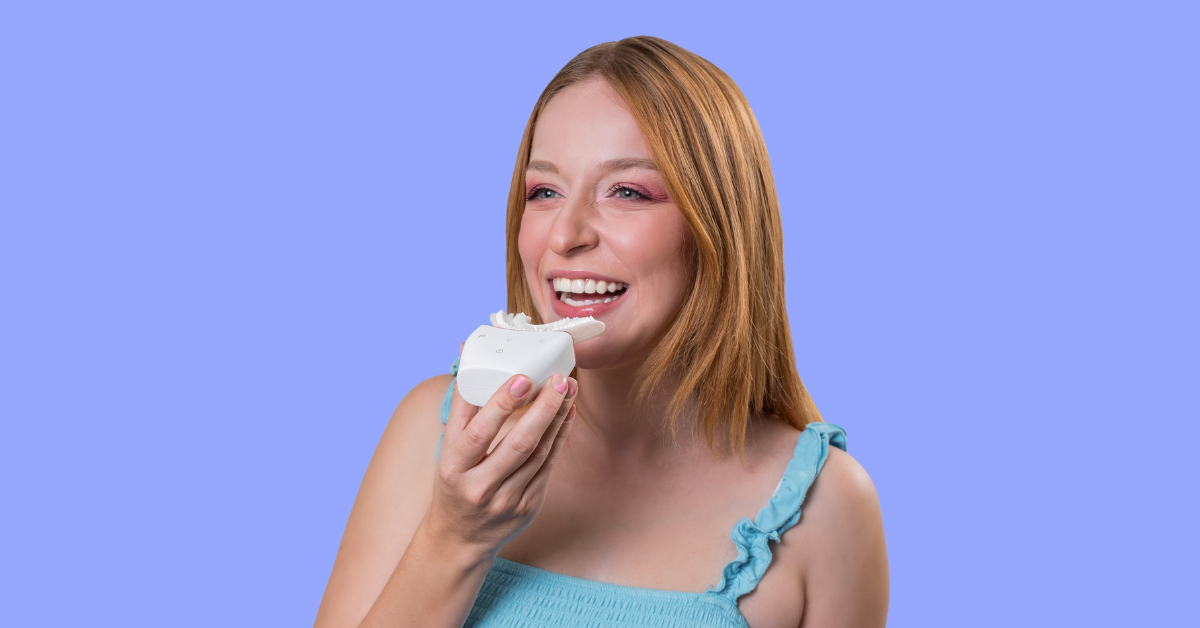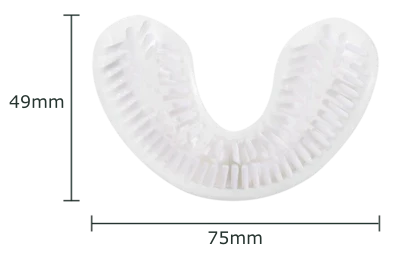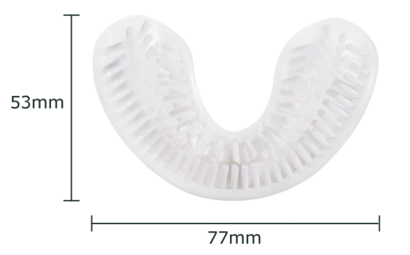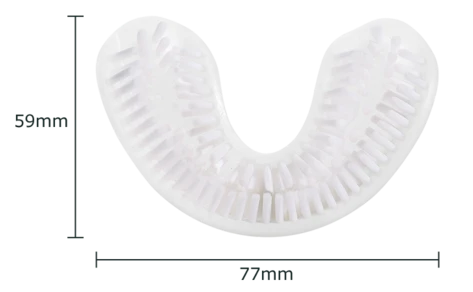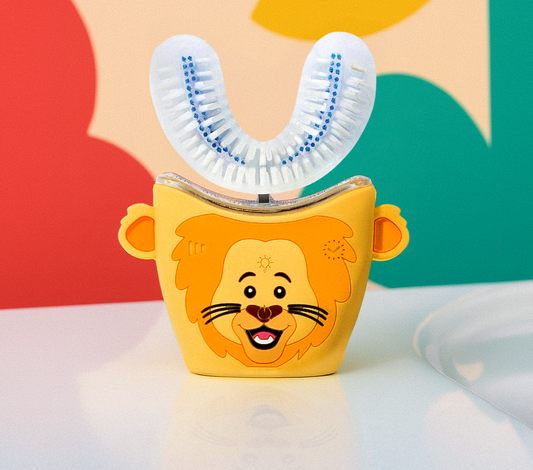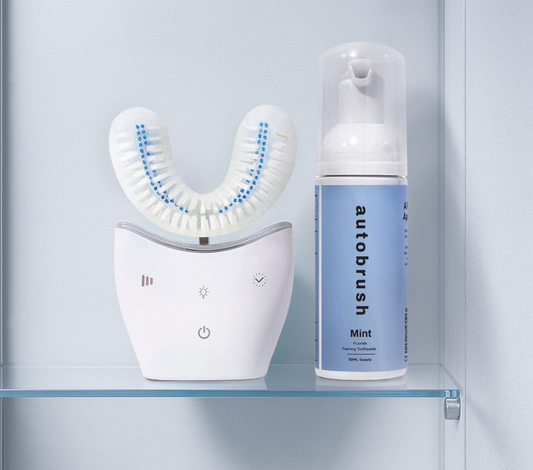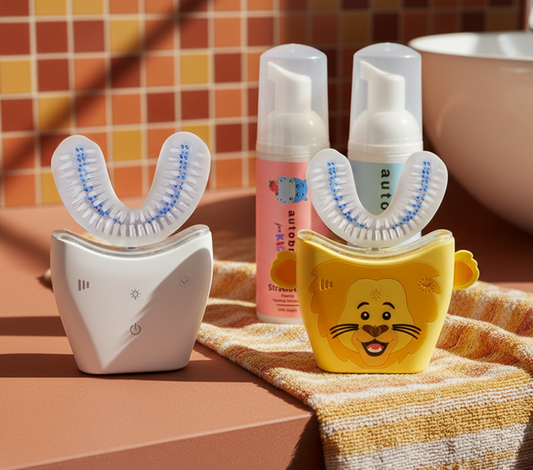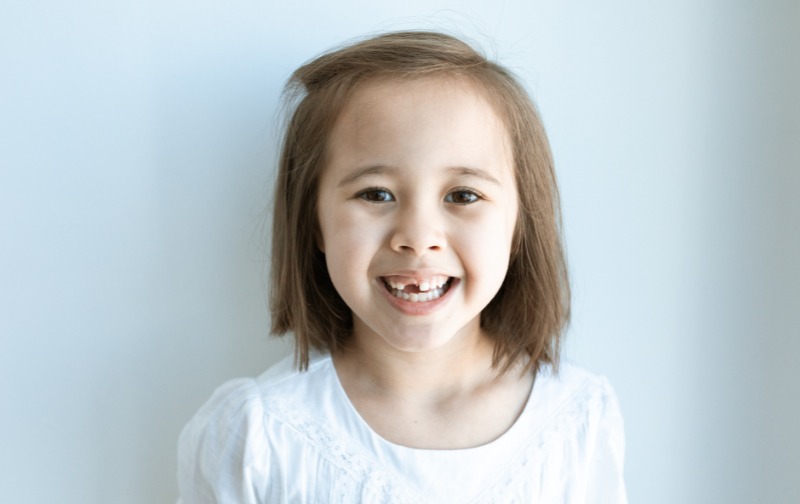
The Ultimate Guide to Toddler Teeth
The Importance of Baby Teeth

Welcome to the ultimate dental care guide for your preschooler – the perfect how-to for parents with little ones ranging from 3-to 5 years old.
(Have a younger brusher? Click here to access the baby brushing guide.)
Your small buddy is growing up and so are their teeth. How exciting! Believe it or not, your kiddo’s baby teeth are critical to their overall health, development, and confidence. This is why protecting them is SO important.
Yet, the American Academy of Pediatrics (AAP) released that 28 percent of children have at least one cavity by age 3 and about half of all children have at least one cavity by age 5.
That’s why I’ve created this guide to help parents like you properly take care of your little one's goofy smile and give you the tools to make dental care fun for the whole family.
This guide will cover the basics on how to take care of your preschooler’s teeth, brushing techniques for independent children, how to motivate your littlest brusher, and what to expect during their annual dental checkups.
Let’s get started!
How to Take Care of Your Preschooler’s Teeth

Brush twice a day
Your little brusher will continue to need your help cleaning their teeth morning and night. It’s especially important to clean their teeth before bedtime since their saliva production slows during this time as well as their mouth’s ability to fight off bacteria.
Oh, and congratulations! Your kiddo has officially graduated from using a rice-sized amount of toothpaste.
The American Academy of Pediatrics (AAP) recommends parents of children aged 3 to 6 use a pea-size amount of toothpaste and encourages parents to help their kids spit their toothpaste out after brushing.
🦷️ Toothy Tip: Always check the back of your toothpaste tube as some advise adult use only + check the expiration date.
Click here to shop kid foam toothpaste in the sweetest flavors: strawberry and bubblegum.
Floss once a day
By now, your little one should have all their teeth and some may even be touching. If so, or by the direction of your pediatric dentist, begin flossing their teeth once a day before bedtime.
Toothy Tip: Make flossing extra fun with colorful giraffe flossers.
Limit sugary snacks & drinks

One of the best ways to protect your child’s teeth is by helping them choose healthy snacks.
Carbohydrates, sugars, and starches are found in many common kid snacks including pretzels, cookies, juices, chewy fruit snacks, and granola bars. Sadly, all of these tasty treats can lead to tooth decay.
While it’s not necessary to eliminate these sugary snacks, it’s recommended to practice moderation with your child.
Healthy snack suggestions that are also teeth-friendly include:
- Celery and peanut butter
- Cucumbers
- Melons
- Cheese sticks
- Yogurt
*If you have further questions about your child’s nutritional needs, talk to your pediatrician.
Offer lots of water
Drinking plenty of water not only keeps your little one hydrated but also assists with washing away food particles lingering in the mouth. Encourage your child to sip on water throughout the day, especially after meals and snack time.
🦷️ Toothy Tip: If you haven’t already, transition your child from using sippy cups to open cups or straws. Sippy cups are damaging to your child’s hard palate which can lead to crooked teeth and bite issues.
Can my preschooler brush their teeth on their own?

Short answer, no. Most children should be supervised while brushing their teeth until they are about 8 years old.
Under your supervision you can be sure that all your child’s teeth are being properly cleaned, reducing your little one’s risk of painful cavities or other dental problems.
However, this is a perfect time to have them practice their brushing skills with your help.
Allow your child to hold their toothbrush independently and practice the skills of brushing. After a few moments, gently guide them on how to brush. Practicing these habits will help strengthen their fine motor skills and build confidence in their oral hygiene habits.
Techniques for Brushing Your Preschooler’s Teeth
How you go about tackling brushing your child’s teeth starts changing around this age. Gone are the days of tooth brushing in your lap – say hello to independence!
Your little one is ready to strengthen their brushing skills (with your guidance). If you haven’t already, begin brushing your child’s teeth in front of a mirror. This allows your little brusher to see the technique involved so they can begin mimicking it.
Toothy Tip. If your child can’t see over the sink, it might be time to consider introducing a kid’s bathroom stool for them to stand on.
The transition from lap brushing to standing can take some getting used to, so below are a couple of techniques to get you started.
Using a Manual Toothbrush
- Prep the brush: Wet the bristles of the toothbrush with warm water before applying a pea-sized amount of toothpaste.
- Support your child: Stand behind your child in front of a mirror. If they are standing on a stool, check that they are stable and comfortable.
- Cup the chin: With their head resting against your chest, gently cup their chin in one hand while holding their toothbrush in the other.
- Brush: Brush the fronts and backs of their teeth with circular motions. Angle the brush at 45° to efficiently clean their gums as well.
- Clean the tongue: Brush your child’s tongue to remove buildup or any remaining food particles.
- Spit out toothpaste: After brushing, encourage your child to spit out the toothpaste rather than swallow.

Using the AutoBrush
- Prep the brush: Attach your child’s double-sided brush head to the AutoBrush body. Apply three pumps of foam toothpaste on each side of the brush head.
- Support your child: Stand behind your child in front of a mirror. If they are standing on a stool, check that they are stable and comfortable.
- Cup the chin: With their head resting against your chest, gently cup their chin in one hand while holding their toothbrush in the other.
- Brush: Move the brush in circular motions to the left and right for thirty seconds. (The brush’s bristles are already angled at 45° to efficiently clean the gumline.)
- Clean the tongue: Brush your child’s tongue with the tongue scraper attachment to remove buildup or any remaining food particles.
- Spit out toothpaste: After brushing, encourage your child to spit out the toothpaste rather than swallow.
Click below to watch a video on how to properly brush your child’s teeth with the AutoBrush.
How to Make Tooth Brushing Fun for Your Child
Find yourself chasing your little brusher down with their toothbrush each night? Unfortunately for us parents, brushing battles are very common around this age. Good news? – They don’t have to last.
As mentioned above, baby teeth are crucial to your child’s overall wellness and development. So before your throw in the towel, try one of the following ways below to get your kiddo motivated about dental hygiene.
Read stories
Try reading stories about your child’s favorite cartoon character learning how to brush their teeth. At this age, your kiddo’s imagination is blooming and storytelling is a great way for them to discover real-life skills in a safe environment.
💡 Need book recommendations?
Sesame Street Ready, Set, Brush! A Pop-Up Book
Let's Brush Our Teeth! (Daniel Tiger's Neighborhood)
Brush Your Teeth, Please: A Pop-up Book
Brush to Music
It may be beneficial to find a kid’s toothbrush, like the AutoBrush, that plays music while your child brushes. Brushing along to silly songs or familiar tunes like Daniel Tiger’s brushing song transforms brushing from a chore to a fun family activity.
Use a sticker chart

Many parents find success motivating their children with small incentives like a sticker chart.
The process is simple.
Every time your child successfully brushes their teeth, they earn a sticker. You can also try taping the chart to the bathroom wall or door to be a helpful reminder of their daily routine.
🦷️Toothy Tip: Not sure how to make your own? Every AutoBrush brush order includes a sticker chart + stickers featuring AutoBrush’s silly jungle characters.
Find the perfect toothbrush for your preschooler
Kids' toothbrushes typically have silly characters that children love like Ziggy the Zebra, Harley the Hippo, Lenni the Lion, Unity the Unicorn, and even Daniel Tiger.
Include your small brushing buddy in choosing their preferred brush so they feel involved.
You can also include them in picking between kid-friendly toothpaste flavors like bubblegum and strawberry.
Lead by example
One of the best ways to teach your child proper technique is by example. Let them watch you brush your teeth and demonstrate spitting toothpaste out instead of swallowing. Encourage them to practice spitting out their toothpaste too.
Not only does brushing together help instill the best habits, but it’s also a great bonding opportunity between you and your child. ( Psst.. If you and your little brush don’t have an AutoBrush yet, check out our Family Pack here. )
Preschooler Toothbrush Maintenance
- Store it correctly: Keep your child’s toothbrush standing up in a cool, dry place between uses to avoid bacteria growth.
- Sanitize it: Soak your kiddo’s toothbrush head in boiling water for 2-3 minutes every week.
- Replace regularly: Use a new toothbrush (or brush head) every 3-4 months or as soon as there are any signs of wear.
- Do not share toothbrushes with others.
When Should Your Child Visit the Dentist?

Keep up your child’s regular pediatric dental appointments.
It’s recommended that your preschooler visits their dentist every 6 months to protect them from dental issues like cavities.
Regular visits will also make the experience more comfortable for nervous children. If your little brusher is especially anxious about visiting the dentist, it can be helpful to talk them through what to expect leading up to their visit.
At your little one's dental visit, it’s a great time to ask your pediatric dentist about…
- Sealants: Sealant is a special coating applied on your child’s molars – specially in the pits and grooves that are harder to brush and are prone to cavities.
- Fluoride treatments: To further help prevent your child from getting cavities, your dentist may paint the front and back of your child’s teeth with a sticky fluoride varnish. The process is typically fairly quick and painless.
- Delayed molar growth: If your child hasn’t erupted their back molars yet, ask your dentist about the next steps.
First Dental X-Ray
As early as 5 years old, your little one may start to lose their teeth. This kickstarts their transition from their 20 baby teeth to 32 adult teeth! During their regular dental visits, your child’s pediatric dentist may want to monitor this new growth with x-rays.
X-rays help dentists see…
- How your child’s adult teeth are growing in the jaw
- If there are any signs of bite problems
- Any other dental problems
Final Thoughts…
You’ve made it to the end!
Preschool is a big milestone for both your child and you. It’s a time of budding independence in all areas – including their oral care habits. They are lucky to have you help them make the best habits.
Before you go, let’s refresh on what we learned:
- Brush your preschooler’s teeth twice a day and floss once a day
- Help your cutie eat a balanced diet
- Practice brushing skills in front of the mirror with your little brusher
- Make brushing FUN with the tips outlined above
- Visit your pediatric dentist regularly
